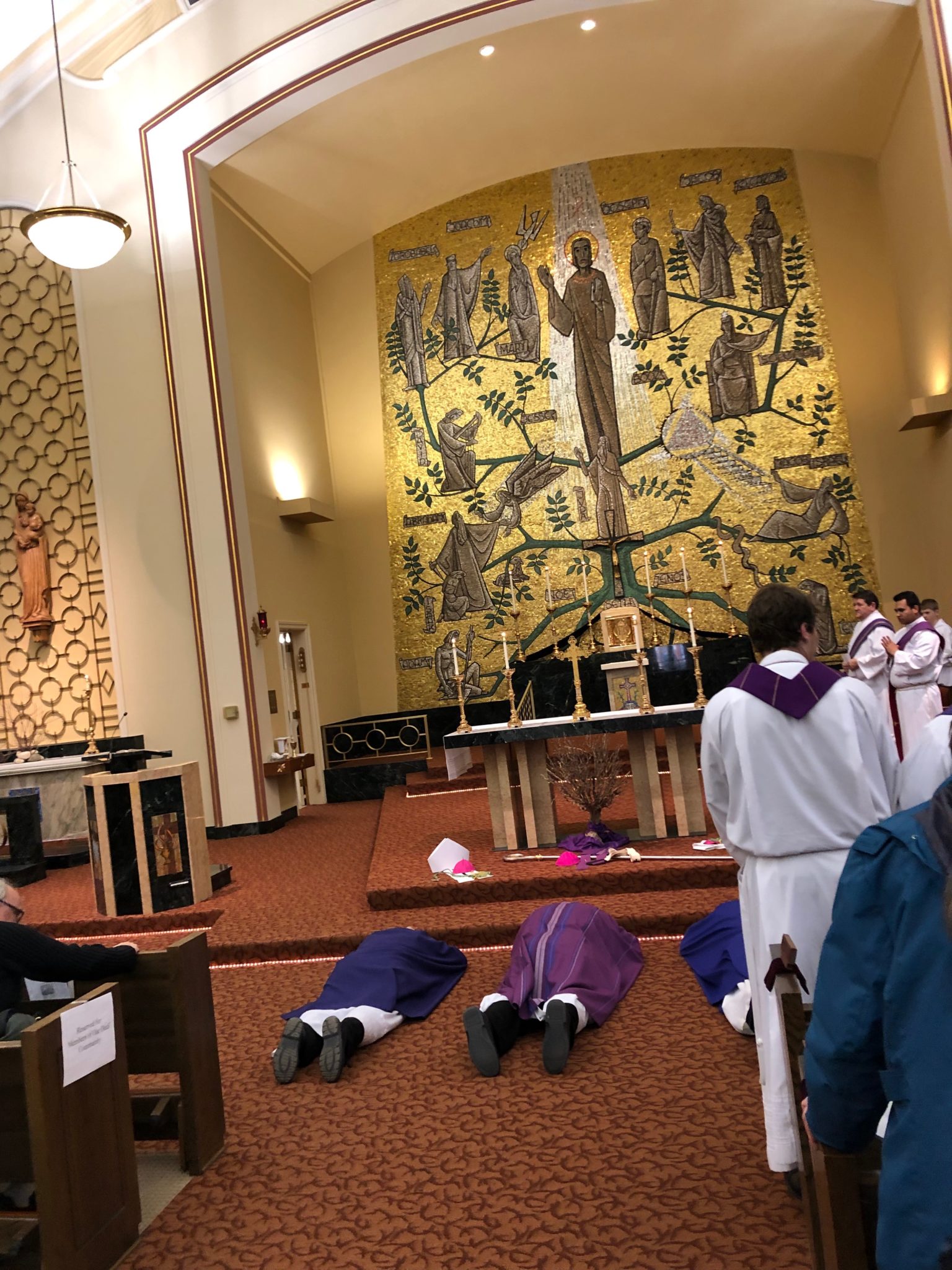COLLEEN JURKIEWICZ
CATHOLIC HERALD STAFF

In a fitting launch to National Child Abuse Prevention month, the Archdiocese of Milwaukee’s annual Mass of Atonement was offered April 1 at Immaculate Conception Church in Bay View.
The Mass, held every April since 2011 at the behest of Archbishop Jerome E. Listecki, is a symbol of repentance on the part of the archdiocese for clergy sexual abuse of children and adults, and the accompanying pattern of denial and cover-up on the part of the Church’s hierarchy.
The liturgy was the latest in a series of a highly visual moments of self-reproach for the archdiocese this spring, coming just a week after the announcement of the removal of the names of Archbishops William E. Cousins and Rembert G. Weakland from two conspicuous Catholic buildings in southeastern Wisconsin — the central offices of the archdiocese and the Cathedral, respectively.
At the beginning of the Mass, immediately following the processional hymn, Archbishop Listecki and Bishops Jeffrey Haines and James Schuerman removed all outward signs of their office — crosiers, miters, zucchettos and rings — and left them at the foot of the altar, an act that set the tone for the remainder of the liturgy.
Archbishop Listecki described this gesture as a way of “approaching the altar of sacrifice as sinful creatures before God.”
“This is a sign of our personal and collective responsibility,” he said. “We cannot approach our God through the lens of power. It must be as humble creatures seeking his love and attention.”
Suzanne Nickolai, director of safeguarding for the archdiocese, said the location of the Mass varies throughout the archdiocese every year as “we understand that so many of our parishes have experienced first-hand abuse and are hurting. It is important that the Mass is accessible to anyone that wishes to attend.”
Attending the Mass, Nickolai noted, is a way for many to “give witness to the bishop’s words and actions” but also to “represent every victim that is unable to attend.” Attending Mass in a Catholic church is sometimes too traumatic for a survivor of clergy sexual abuse, she said.
“The Mass of Atonement is not only about apologizing for the failings of the past, but also about remembering and acknowledging the courage of the victims that shared their stories so that the long and painful road to healing could begin.”
In his homily, the archbishop reflected on the scene of Christ crucified in between two thieves — the sinless Lamb, flanked by the guilty, whose responses to Jesus “could not be more different.”
“One mocked and demeaned Jesus, taunting him to save himself and them. The bad thief desired the interests of the world and wanted to avoid the punishment which was his responsibility for his actions. He didn’t care about the relationship offered to him in faith. He just wanted Jesus to magically make it all disappear,” he said.
He implored the Church to take the path of the thief who called out to Jesus, acknowledging his own sin.
“The bad thief represents the world, which seeks power and manipulation for self-interest and personal gain; the good thief took responsibility for his action and recognized the innocence of Jesus. In doing so, he begs Jesus to remember him when he comes into his kingdom. The first step towards atonement for sin is the recognition of our responsibility for those actions which have separated us from God.”
The Mass of Atonement, he continued, is not only a representation of penitence, but must also be a call to action.
“We are not only saying we are sorry for our sins, but we commit ourselves to correct the behavior that permitted sins to occur. We entrust ourselves to the only source that can accomplish true healing — that is the love of God,” he said. “We begin the journey of reconciliation, not from the position of perfection or power, but as frail human beings in need of God’s abundant mercy, standing before the cross of sacrifice of Jesus. We come as beggars before the altar of the Lord to be fed by the love that Jesus demonstrates in the sacrifice. Our action must begin at the foot of the cross.”
In describing the failure of the Church’s members to correctly address the abuse crisis, both historically and in the present day, the archbishop said that “as a Church, we shamefully and remorsefully acknowledge that there were those clergy and others among us that abused our children, the most vulnerable entrusted to our care. There was also silence, dismissing the cries of those hurting and magnifying the distrust. There was ignorance on the part of many and a lack of understanding the gravity of sin all of which inflicted wounds on the Body of Christ.”
There was a sign language interpreter present at the Mass to interpret for the members of the deaf community, for whom several rows of pews were reserved. “Our deaf community was deeply hurt by abuse,” said Nickolai. “A sign language interpreter is always present at the Mass of Atonement and pews are reserved specifically for any member of the deaf community. As we continue to look at our outreach to victims, we will continue to make sure that our efforts are accessible and inclusive to all communities of victims.”
The Archbishop concluded his homily by saying that the purpose of the Mass is not only apology, for “we can never apologize enough” — but remembrance.
“(It is) most importantly to remember and never forget that it was our sin that damaged the Body of Christ — and it is only through embracing the cross that we have any ability to bring about reconciliation and healing.”
